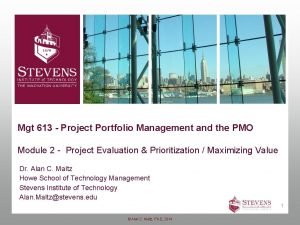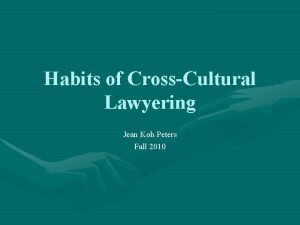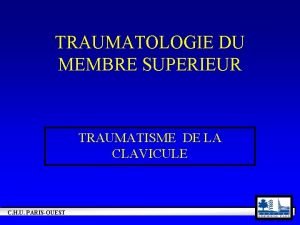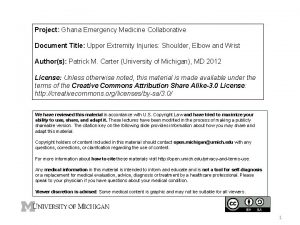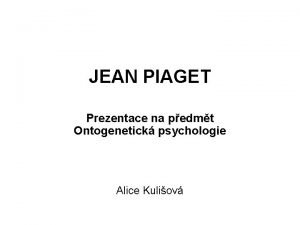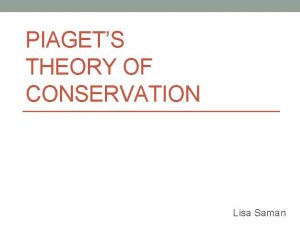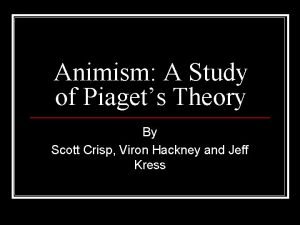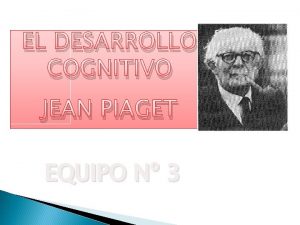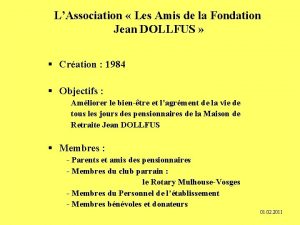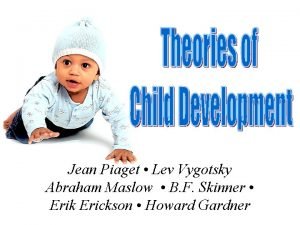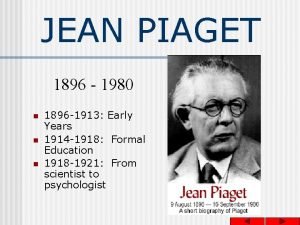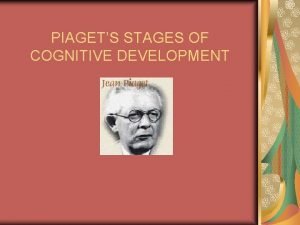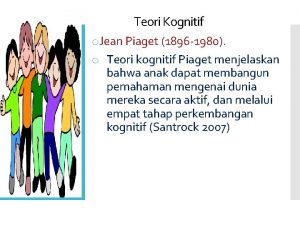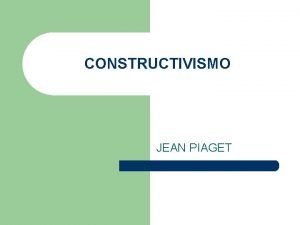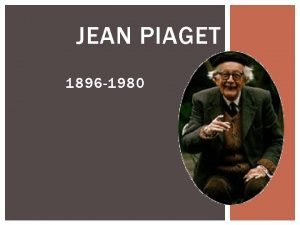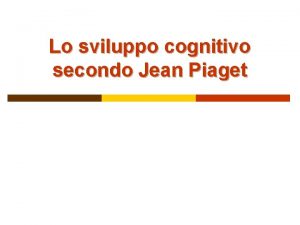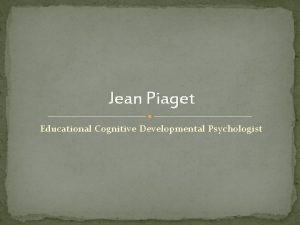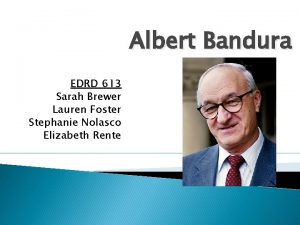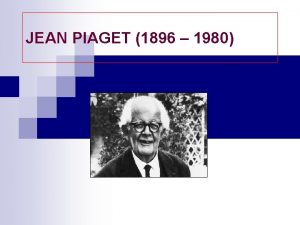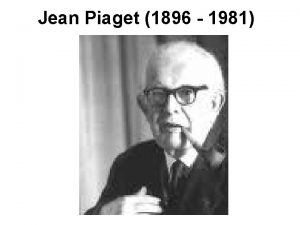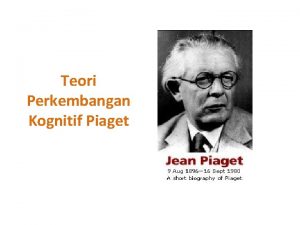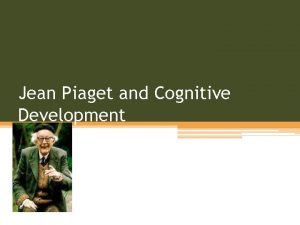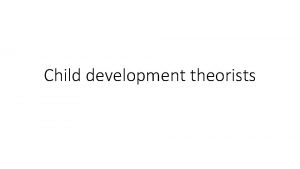Jean Piaget EDRD 613 Suzanne Peters Lexi Allman





















- Slides: 21

Jean Piaget EDRD 613 Suzanne Peters Lexi Allman Amanda Fecik

Biography Born in Neuchatel, Switzerland in 1896 l He found his mother somewhat neurotic which led to his interest in psychology l He published his first paper when he was 10! l He wanted to find a biological explanation of knowledge – his search started with philosophy and ended with psychology l

Biography l l l 1918 – earned a Doctorate in Science – began teaching philosophy and psychology and researched how children reason which led to his 1 st 5 books 1923 – married; had 3 children; 3 rd was a boy who he used for further observations which led to his next 3 books! 1929 – 1967: director of International Bureau of education; influential in bringing women into experimental psychology He had many other jobs and honorary degrees; he wrote over 60 books and hundreds of articles; he continued to tie his psychology work to biology for many years Died in 1980

Theory Throughout his life Piaget became interested in the nature of thought itself. He called it genetic epistemology. l He found that at a certain age children could solve a reasoning problem, but at an earlier age, they nearly always gave the same wrong answer. This led to his Cognitive Stages. l He developed and named four cognitive stages: l ü ü Sensorimotor Preoperational Concrete Operations Formal Operations

How do we adjust the new information we learn from our environment? Adaption l Assimilation - We incorporate the new information with existing ‘cognitive structures’ or information. l Accommodation - We change our existing cognitive structures to include new information. l Equilibrium - A balance between the two (assimilation & accommodation).

4 Concrete Strategies

Sensorimotor Stage l Infancy to 2 years old l Intelligence is shown through motor activity without the use of symbols l Beginning to develop knowledge based on physical interactions and experiences l Develop object permanence l Start to begin physical mobility l At the end of stage – develop symbolic language

Preoperational Stage Usually between 2 -7 years old l Use of symbols (something that represents something else) • Ø Examples: Language and Creative Play – (i. e. checkers are cookies) Understanding of past and future l Child is egocentric (sees things from his own point of view) l Can center in on only one part of a problem or communication at a time. l

Preoperational Stage l Inability to conserve liquid volume l Children reason based on how things appear rather than on logic

Preoperational Stage l Overgeneralization (i. e. all things on our feet are called shoes) l When the child is able to decenter he is moving on to the next stage.

Concrete Operations Stage l Begins around the age of 7. l Categorization: Can arrange things in order. Ø Seriation: can arrange objects by a dimension. (Ex. Weight) Ø Transitive: can infer relationships between two objects based on a third (Ex. Sticks) Ø Class Inclusion: can understand the difference between a whole and it’s parts

Concrete Operations Stage l Inductive and Deductive Reasoning: Logical reasoning where observations become general conclusions Ø Logical reasoning that changes a conclusion about a whole group to particular members of the group Ø l Conservation: Identity: an object is the same even when moved to a different shape Ø Reversibility: Once an object is molded it can be switched back Ø Decenter: focus on two dimensions Ø

Concrete Operations Stage l Number and Mathematics: Ø Can count in their heads Ø Can count on Ø Can solve simple story problems l Spatial Thinking: Can tell how far it is from one place to another and how long it might take to get there

Formal Operations Stage l Enter stage around age of 12 l They become confident in adult style thinking. l They use logical operations. They use them in the abstract rather than the concrete – Hypothetical Thinking

Formal Operations Stage l Grouping in four different ways Ø Conjunction Ø Disjunction Ø Implication Ø Incompatibility

Formal Operations Stage l This is a stage that everyone may not get to. l Some cultures don’t develop or value it like “we” do. l Abstract reasoning is simply not universal.


In the Classroom l Allowing the students to make mistakes. Ø • • • Discover their own errors and correct them. Obtain insights into the child’s view of the world Provide appropriate materials Ask encouraging questions Allow the child to construct his own knowledge Hands on and concrete experiences Explore the nature of things through trial and error.

4 Cognitive Stages http: //www. youtube. com/watch? v=9 yh. Xj. JV FA 14

References l http: //webspace. ship. edu/cgboer/piaget. ht ml l http: //www. pbs. org/wgbh/aso/databank/e ntries/dh 23 pi. html l http: //www. web. pdx. edu/~youngt/Psy 311 Web. Skinner/PSY 311 U%20 Lecture%20 files /Ellen's%20 Slides%20 PDF/06. Piaget. pdf l http: //psychology 4 a. com/develop 2. htm

References l http: //www. edpsycinteractive. org/topics/c ognition/piaget. html l http: //www. scholastic. com/teachers/articl e/pioneers-our-field-jean-piaget-championchildrens-ideas l Papalia, D. E. , Olds, S. W. , Feldman, R. D. (2007). Human Development. Mc. Graw. Hill: Boston, MA.
 Et 613
Et 613 Mgt 613
Mgt 613 Aama 613
Aama 613 Jean koh
Jean koh Classification de neer clavicule
Classification de neer clavicule Colles fracture
Colles fracture Jean piaget referat
Jean piaget referat 1896-1980
1896-1980 Jean piaget
Jean piaget Piaget's conservation
Piaget's conservation Animism piaget
Animism piaget Ejemplo de adaptacion segun piaget
Ejemplo de adaptacion segun piaget Jean piaget graphic organizer
Jean piaget graphic organizer Jean piaget wikipedia
Jean piaget wikipedia Jean piaget theory
Jean piaget theory Fondation jean dollfus
Fondation jean dollfus Jean piaget lev vygotsky
Jean piaget lev vygotsky Jean piaget 1896-1980
Jean piaget 1896-1980 Teoria de inteligencia de piaget
Teoria de inteligencia de piaget Escuela jean piaget
Escuela jean piaget Piaget concrete operational stage
Piaget concrete operational stage Jean piaget (1896-1980)
Jean piaget (1896-1980)

